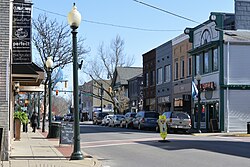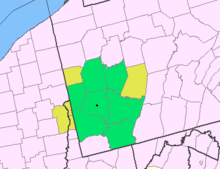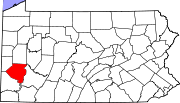world.wikisort.org - USA
Sewickley is a borough in Allegheny County, Pennsylvania, 12 miles (19 km) west northwest of Pittsburgh along the Ohio River. It is a residential suburb of Pittsburgh. The population was 3,827 according to the 2010 census. The Sewickley Bridge crosses the Ohio River from Sewickley to Moon Township.
Sewickley, Pennsylvania | |
|---|---|
Borough | |
| Borough of Sewickley | |
 Sewickley in March 2016 | |
 Location in Allegheny County and the U.S. state of Pennsylvania. | |
 Sewickley, Pennsylvania  Sewickley, Pennsylvania | |
| Coordinates: 40°32′11″N 80°11′04″W | |
| Country | United States |
| State | Pennsylvania |
| County | Allegheny |
| Government | |
| • Type | Mayor-council government |
| • Mayor | George Shannon[1] |
| • Manager | Marla P. Marcinko |
| Area | |
| • Total | 1.12 sq mi (2.90 km2) |
| • Land | 1.00 sq mi (2.59 km2) |
| • Water | 0.12 sq mi (0.31 km2) |
| Elevation | 741 ft (226 m) |
| Population (2010) | |
| • Total | 3,827 |
| • Estimate (2019)[3] | 3,791 |
| • Density | 3,794.79/sq mi (1,464.62/km2) |
| Time zone | UTC−5 (Eastern (EST)) |
| • Summer (DST) | UTC−4 (EDT) |
| ZIP codes | 15143 |
| Area code | 412 |
| FIPS code | 42-69376 |
| GNIS feature ID | 1187277 |
| Website | www |
Etymology
Historian Charles A. Hanna suggested "Sewickley" came from Creek words for "raccoon" (sawi) and "town" (ukli).[4] According to Hanna, the Asswikale branch of the Shawnee probably borrowed their name from the neighboring Sawokli Muscogee before the former's migration from present-day South Carolina to Pennsylvania. Contemporary accounts from noted anthropologist Frederick Webb Hodge[5] and the Sewickley Presbyterian Church,[6] as well as the current Sewickley Valley Historical Society[7] concur to varying degrees with Hanna's etymology. Some locals alternatively consider Sewickley to be a Native American word meaning "sweet water."[8]
Geography
Sewickley is located at 40°32.25′N 80°10.5′W (40.5390, -80.1807).
According to the United States Census Bureau, the borough has a total area of 1.1 square miles (2.8 km2), of which, 1.0 square mile (2.6 km2) of it is land and 0.1 square miles (0.26 km2) of it (11.11%) is water.
Surrounding and adjacent neighborhoods
Sewickley has four land borders with Edgeworth to the northwest, Glen Osborne to the southwest, Sewickley Heights to the northeast, and Aleppo Township to the east. Across the Ohio River, Sewickley runs adjacent with Moon Township and Coraopolis with the Sewickley Bridge as the direct link to the former.
Along with the four land borders, plus Bell Acres, Glenfield, Haysville, Leetsdale, Leet Township, and Sewickley Hills, Sewickley is located in the Quaker Valley School District. Together, these boroughs and townships constitute a loosely defined region in northwestern Allegheny County. Most of these municipalities – not including Leetsdale and parts of Leet Township – share the Sewickley post office and its 15143 zip code.
Demographics
| Historical population | |||
|---|---|---|---|
| Census | Pop. | %± | |
| 1860 | 795 | — | |
| 1870 | 1,472 | 85.2% | |
| 1880 | 2,053 | 39.5% | |
| 1890 | 2,776 | 35.2% | |
| 1900 | 3,563 | 28.4% | |
| 1910 | 4,479 | 25.7% | |
| 1920 | 4,955 | 10.6% | |
| 1930 | 5,599 | 13.0% | |
| 1940 | 5,614 | 0.3% | |
| 1950 | 5,836 | 4.0% | |
| 1960 | 6,157 | 5.5% | |
| 1970 | 5,660 | −8.1% | |
| 1980 | 4,778 | −15.6% | |
| 1990 | 4,134 | −13.5% | |
| 2000 | 3,902 | −5.6% | |
| 2010 | 3,827 | −1.9% | |
| 2019 (est.) | 3,791 | [3] | −0.9% |
| Sources:[9][10][11][12][13][14][15] | |||
The population of Sewickley peaked in the 1960 census, with over 6,000 residents. As of the 2010 census, there were 3,827 people with 1,765 households and 950 families residing in the borough's 1,965 housing units. The racial makeup of the borough was 88.8% White, 7.3% African American, with the remainder of other races or multi-racial. No other single race represented more than 2% of the population. Hispanics represented less than 2% of the population.[16]
According to the 2011–15 American Community Survey, the median household income in the borough was about $91,735 and the median family income was $118,507. The per capita income for the borough was about $54,149.[16]
Government and politics
| Year | Republican | Democratic | Third Parties |
|---|---|---|---|
| 2020[17] | 38% (938) | 60% (1,514) | 2% (54) |
| 2016[18] | 40% (819) | 58% (1,192) | 2% (27) |
| 2012[19] | 51% (1,081) | 48% (1,004) | 1% (21) |
Sewickley is divided into wards and is governed by a mayor and a nine-member borough council composed of three members from each ward. Members are elected to four-year terms. The current mayor of Sewickley is George Shannon.[1][20]
Councilmembers
The current members of council are Jeff Neff (President), Todd Renner (Vice President), Sean Figley (President Pro Tempore), Christine Allen, Julie Barnes, Ed Green, Cynthia Mullins, Larry Rice, and Thomas Rostek.
Education
There are several private schools in the area, including Sewickley Academy, St. James Catholic School, Eden Christian Academy, and Montessori Children's Community. The public school system, Quaker Valley School District, is renowned for an innovative laptop-technology grant received in 2000 from former Pennsylvania governor Tom Ridge. Quaker Valley School District is often regarded as one of the best and academically top-ranked school districts in the nation. In the spring of 2006, U.S. News & World Report ranked Quaker Valley High School among the top 2% of high schools nationwide. The Sewickley Public Library of the Quaker Valley School District is a Library Journal Star Library for the third year in a row [21] and is continuously one of the top 25 largest libraries in the Pittsburgh Business Times Book of Lists.[22]
Health care
Sewickley is home to Sewickley Valley Hospital, which is part of the Heritage Valley Health System. Heritage Valley Sewickley provides comprehensive health care for residents of Allegheny, Beaver, Butler and Lawrence counties in Pennsylvania; eastern Ohio and the panhandle of West Virginia.
Heritage Valley offers medical, surgical and diagnostic services at its hospitals, community satellite facilities and in physician offices. Heritage Valley Health System's affiliated physician groups include Heritage Valley Medical Group, Tri-State Obstetrics and Gynecology and Heritage Valley Pediatrics.
Notable people
- Tom Barrasso, former Pittsburgh Penguins goalie
- Michael Cerveris, actor and musician
- Caitlin Clarke, Broadway and film star, lived here since the age of 10
- Dan Cortese, actor and former MTV VJ
- Sidney Crosby, Pittsburgh Penguins player, lives here[23]
- William Fitzsimmons, musician
- Sergei Gonchar, Pittsburgh Penguins assistant coach and former player, lives here
- Christa Harmotto, Olympic volleyball player, born here.
- Franco Harris, retired Pittsburgh Steelers player, lives here
- Chuck Knox, former NFL head coach, born and raised here
- Ray Krawczyk, professional baseball player
- Mario Lemieux, former Pittsburgh Penguins player, lives here[24]
- Evgeni Malkin, Pittsburgh Penguins player, lives here
- Wentworth Miller, actor, graduated from Quaker Valley High School
- Charles I. Murray, Brigadier General, USMC; recipient of Navy Cross and Army Distinguished Service Cross
- Chuck Noll, longtime NFL head coach, lived here
- Rissi Palmer, country music artist, born and raised here until age 12
- Keith Rothfus, former U.S. Representative for Pennsylvania's 12th district, lives here
- Bianca Smith, professional baseball coach, born here[25]
- George R. Stewart, author, born here
- Kathleen Tessaro, novelist, lives here
- Mike Tomczak, former Pittsburgh Steelers quarterback
- Ken Whitlock, pro football player, first black player for the Toronto Argonauts[26]
In popular culture
In 1995, the movie Roommates was filmed in and around Pittsburgh, Pennsylvania including Sewickley. Roommates starred Peter Falk, D. B. Sweeney, and Julianne Moore, and was directed by Peter Yates. The same year, parts of the movie Houseguest was filmed in Sewickley including Sewickley's main streets, Broad Street and Beaver Street. The Bruegger's Bagels on Beaver Street was temporarily transformed into an operating McDonald's during shooting of Houseguest. In 2002, parts of The Mothman Prophecies were filmed in the Sewickley area. Scenes from the Netflix show Sweet Magnolias was also filmed at the intersection of Broad Street and Beaver Street. Scenes from Jack Reacher, starring Tom Cruise, and The Lifeguard, starring Kristen Bell, were filmed in the town near the Sewickley Manor apartments and condominiums.[27] Foxcatcher, starring Steve Carell, Mark Ruffalo, and Channing Tatum, began filming in the Sewickley area in October 2012.[28]
The fictional 1/24 scale town of Elgin Park, by artist and photographer Michael Paul Smith, was loosely based on Sewickley.[29][30]
Sid Lang, a primary character in Wallace Stegner's 1987 novel Crossing to Safety, grew up in Sewickley.[31]
Sewickley Cemetery
In 1860 Sewickley Cemetery was opened. The cemetery is now the resting place of more than 12,000 people. There are also two war memorials located on the burial grounds.[32]
Civil War Memorial
There is a monument celebrating the local Civil War veterans - it is 20 feet tall and was installed in 2005. There was an 1866 statue which depicted a soldier on bended knee; but that statue was damaged from many years of weather.[32]
Tuskegee Airmen Memorial
The Tuskegee Airmen have been memorialized in the cemetery with 2 large black granite blocks. the blocks are inscribed with the names of Western Pennsylvania veterans. Another block shows a scene of 2 planes engaged in arial combat.[33][34]
See also
- List of cities and towns along the Ohio River
References
- Divittorio, Michael (January 12, 2021). "Sewickley has a new mayor, George Shannon". Pittsburgh Tribune Review. Retrieved January 14, 2021.
- "2019 U.S. Gazetteer Files". United States Census Bureau. Retrieved July 28, 2020.
- "Population and Housing Unit Estimates". United States Census Bureau. May 24, 2020. Retrieved May 27, 2020.
- Charles Augustus Hanna (1911). "The Traders at Allegheny on the Main Path; With Some Annals of Kittanning and Chartier's Town". The Wilderness Trail: Or, The Ventures and Adventures of the Pennsylvania Traders on the Allegheny Path. Vol. 1. New York and London: G. P. Putnam's Sons. p. 298. ISBN 9780598504005. Retrieved December 5, 2016.
- Smithsonian Institution Bureau of American Ethnology (1907). Frederick Webb Hodge (ed.). Handbook of American Indians North of Mexico: A-M. Washington: U.S. Government Printing Office. p. 536. Retrieved December 6, 2016.
sewickley.
- Presbyterian Church (Sewickley, Pa.) (1914). A history of the Presbyterian Church of Sewickley, Pennsylvania: consisting of certain addresses, delivered February 16-19, 1913, on the occasion of the seventy-fifth anniversary of the permanent organization of the church ... New York: Knickerbocker Press. pp. 80–. Retrieved December 5, 2016.
- "The Origin of the Name "Sewickley"". Sewickley Valley Historical Society. Retrieved March 14, 2017.
- History of Allegheny County, Pennsylvania. A. Warner & Co. 1889. p. 196. ISBN 9780788446146. Retrieved March 14, 2017.
- "Population of Civil Divisions Less than Counties" (PDF). 1880 United States Census. U.S. Census Bureau. Retrieved November 24, 2013.
- "Population-Pennsylvania" (PDF). U.S. Census 1910. U.S. Census Bureau. Retrieved November 22, 2013.
- "Number and Distribution of Inhabitants:Pennsylvania-Tennessee" (PDF). Fifteenth Census. U.S. Census Bureau.
- "Number of Inhabitants: Pennsylvania" (PDF). 18th Census of the United States. U.S. Census Bureau. Retrieved November 22, 2013.
- "Pennsylvania: Population and Housing Unit Counts" (PDF). U.S. Census Bureau. Retrieved November 22, 2013.
- "U.S. Census website". United States Census Bureau. Retrieved January 31, 2008.
- "Annual Estimates of the Resident Population". U.S. Census Bureau. Archived from the original on November 20, 2013. Retrieved November 22, 2013.
- "U.S. Census website". United States Census Bureau. Retrieved May 14, 2011.
- "Primary and General Election Results". Allegheny County. Retrieved January 14, 2021.
- EL. "2016 Pennsylvania general election results". Pittsburgh Post-Gazette. Retrieved October 15, 2017.
- EL. "2012 Allegheny County election". Pittsburgh Tribune-Review. Retrieved October 15, 2017.
- Borough Council & Mayor
- Ray Lyons and Keith Curry Lance. "America's Star Libraries, 2011: Top-Rated Libraries". Library Journal.
- "Book of Lists". Pittsburgh Business Times. 2012. ISSN 1097-1394.
- Anderson, Shelly; Molinari, Dave (May 13, 2010). "Penguins Notebook: Crosby buys house not far from Lemieux's". Pittsburgh Post-Gazette. Archived from the original on May 16, 2010. Retrieved July 13, 2010.
- Bombulie, Jonathan (July 24, 2018). "Penguins owner Mario Lemieux lists Quebec castle for $21,999,066". Retrieved July 27, 2018.
- Persak, Mike (January 11, 2021). "Sewickley-born Bianca Smith finally gets chance to focus on baseball alone with Red Sox". Pittsburgh Post-Gazette. Retrieved February 19, 2021.
Smith was born in Sewickley, but most of her upbringing took place in Grapevine, Texas.
- Ove, Torsten (February 4, 2012). "Star Sewickley athlete, first black Marine from area". Pittsburgh Post-Gazette. p. A-11. Retrieved August 17, 2021 – via Newspapers.com.
- Tady, Scott (July 10, 2012). "'Lifeguard' movie shoots in Sewickley". Beaver County Times. Retrieved July 18, 2012.
- Serafini, Kristina (October 17, 2012). "Film crews back in Sewickley area". Pittsburgh Tribune-Review. Retrieved October 18, 2012.
- "Michael Paul Smith's Elgin Park at Sewickley Public Library | Explore Sewickley". Archived from the original on December 29, 2014. Retrieved December 29, 2014.
- "American Life: Michael Paul Smith's Elgin Park". June 27, 2013.
- Stegner, Wallace (1987). Crossing to Safety. New York: Random House. p. 80. ISBN 978-0-375-75931-4.
- Wills, Rick (June 3, 2010). "Sewickley cemetery 'centerpiece' of town's history". Trib Total Media, LLC. Retrieved August 17, 2020.
- Isenberg, Robert (September 9, 2011). "Tuskegee Airmen Honored at Sewickley Cemetery". Neighbor News. Retrieved August 16, 2020.
- "Sewickley Cemetery now home to Tuskegee Airmen Memorial". Hearst Television Inc. Action News Pittsburgh. September 15, 2013. Retrieved August 16, 2020.
External links
 Sewickley travel guide from Wikivoyage
Sewickley travel guide from Wikivoyage- Borough of Sewickley website
- / marketing campaign for Sewickley including a store directory and event calendar
- Post-Gazette article on Sewickley Garden Tour
Другой контент может иметь иную лицензию. Перед использованием материалов сайта WikiSort.org внимательно изучите правила лицензирования конкретных элементов наполнения сайта.
WikiSort.org - проект по пересортировке и дополнению контента Википедии

